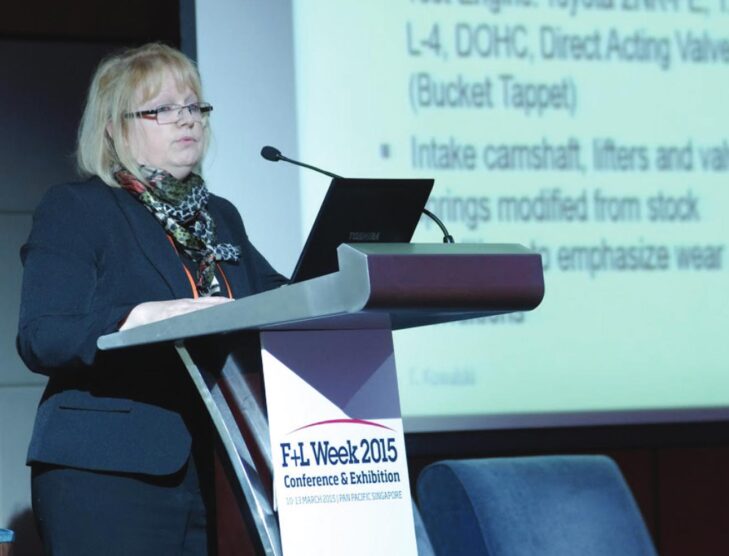
New specifications for gasoline engine oils: Latest developments and timelines
By Alison Gaines
Fuel economy, emission system compatibility and protection of engines: these are the needs behind the new engine oil specifications being developed today. During F+L Week 2015 in Singapore in March, participants heard the latest developments in new gasoline engine oil specifications. Both ILSAC GF-6 and the second generation of the dexos1™ specification from General Motors have unprecedented components this time around. Partly for this reason, the first license date for GF-6 has been moved back to January 2018, with mandatory use one year later.
Teri Kowalski, senior principal engineer for Toyota in the Vehicle Research & Certification Engineering Department, predicts that the industry precision matrix for GF-6 tests will begin in May and will take at least three months. The precision matrix determines if the tests are repeatable and reproducible across different labs and across iterations.
Two sub-categories of GF-6 are being developed. GF-6A is fully backward compatible, whereas GF-6B is designed for low-viscosity engine oils. Oils with viscosity grades lower than SAE 0W-16 will require approval by the Auto Oil Advisory Panel (AOAP).
GF-6 is composed of six new engine tests, four of which are replacing tests for the current GF-5 category and two of which are brand new. Not all of these tests have been accepted by AOAP yet, and this will not happen until after the industry precision matrix is completed.
The four replacement tests include a GM-sponsored Oxidation and Deposit test (GMOD) and the Chrysler Oxidation and Deposit Test. Both have been proposed to replace the current Sequence IIIG test, and have similar conditions, although they both exclude a wear test component. The AOAP still has to decide which of the two will replace the Sequence IIIG. It is possible that both will be used.
Ford is sponsoring the Sequence VH sludge test. It is being developed to correlate to Sequence VG, and all test hardware will be compatible for both. There has been difficulty in getting this test to be as severe as the last, Kowalski said. The Sequence VG was one of the oldest tests in GF-5, using a 1994 Ford 4.6-L V8 engine, and the Sequence VH will use a 2013 version of the same engine. New engine control units (ECU) are being programmed for this test. Kowalski also said that new fuel batch specifications could slow the process.
GM is also sponsoring the Sequence VIE test to measure fuel economy. The 2009 3.6-L V6 engine used for GF-5 tests is out of production, so GF-6 will use a 2012 version of the same engine. Compared to the VID, this test has a 500 ml greater oil charge and a longer ageing portion of the test, as well as longer stabilization periods. Concerns with this test include a shorter engine life and problems with a specific friction modifier carry-over effect.
Toyota is sponsoring the Sequence IVB Valvetrain Wear test. Toyota partnered with Chevron Oronite to develop this test so that it would mirror the conditions of the Sequence IVA test, the hardware for which is becoming increasingly scarce. They selected a Toyota 2NR 4-cylinder engine based on its long-term availability, and modified the intake camshaft, lifters and valve springs so that wear conditions would be emphasised. The intake lifters were found to be the most sensitive to wear.
With this test, Toyota proposed and introduced its Golden Stand concept. Ensuring that all the stands are identical across the different labs gives a greater chance of repeatability and reproducibility, so Toyota selected Southwest Research (SwRI) to design and document the construction of the Golden Stand. TEI then supplied the stands according to the SwRI design, and eight stands now exist: four at SwRI, three at Intertek and one at Lubrizol.
“This has been a well-received concept,” Kowalski said, because the stands were easy to install and have displayed minimal variability.
Ford is sponsoring both of the tests completely new to GF-6. One of these, the Chain Wear test, addresses the concern that the valve timing chain is sensitive to new oil formulations. This test was supposed to have been introduced for GF-4 and GF-5, and hopefully will be ready for GF-6. It is now being developed at SwRI and Intertek.
The second new test for GF-6 monitors low-speed pre-ignition (LSPI), a growing concern with small displacement engines. Ford is using the same engines for the chain wear and LSPI tests, a 2012 2.0-L L4. Initial testing discriminated among three oils of low, medium and high LSPI occurrence. The cylinder pressure measures LSPI events, and earlier problems with the pressure transducer have been resolved. New transducers and a new ECU are duplicating prior testing with low and high LSPI oils, and the new ECU calibration allows a certain number of LSPI events to occur without damaging the engine.
This number of new tests for one category is unprecedented, Kowalski said. Also unprecedented is the simultaneous development of the PC-11 category for heavy-duty diesel engine oils. In previous iterations, the releases of the gasoline and diesel categories were staggered. Some of the same people are working on both specifications, so human and material resources have been stretched thin.
Because of these new challenges, it is not surprising that the category has so far been about four and a half years in the making. With only one new test, GF-5 took four years to develop, Kowalski said. But, she added, “We are seeing the light at the end of the tunnel.” All parties involved have signed the Memorandum of Agreement and have agreed on the Needs Statement. All funding for the precision matrix has been collected as well. Matrix test labs and reference oils have also been designated.
There are two pressure points for completing the testing: First, four out of the five tests for the current GF-5 category will cease to be available in 2016 and 2017. And, “OEMs [original equipment manufacturers] want to take advantage of the fuel economy benefits of oils that comply to these higher specifications,” said Kowalski, “and they can’t do that until the oils are available in the marketplace.”
INSIGHT INTO A SINGLE TEST
Kaustav Sinha, project manager for Chevron Oronite leading the GF-6 and Dexos1™ developments globally, gave an update on the Chrysler Oxidation and Deposit Test for GF-6, on behalf of the test development team comprising members from Fiat Chrysler Automotive, Shell, Chevron Oronite, SwRI and Haltermann. Sinha’s talk emphasised just how much a test needs to go through before it can even enter the industry precision matrix. The test uses a 2014 PentaStar 3.6-L V6 engine (the Sequence IIIG runs on a 1996 GM Powertrain 3800 V6 engine, which is no longer in production). It runs for 90 hours, with a six-ounce addition of oil every 20 hours. SwRI, IAR, Lubrizol, Afton and Ashland have installed the test and contributed to the prove-out matrix data generation.
The test focuses on oxidation performance as well as kinematic viscosity increase (%)—which is an indicator of a lack of oxidation stability— and weighted piston deposits (WPD). It also has to be backward compatible with the Sequence IIIG test, so much of the test development involves comparing the reference oils for the old and new tests to make sure that the GF-6-compliant oil is compatible for vehicles that had been using the GF-5 oils.
The developers had to collect data on repeatability, reproducibility and discrimination for traits including percent viscosity increase (PVIS), WPD, phosphorus retention and compatibility with 0W-16 oils. In each case, the focus was to make sure that the reference oils could discriminate performance for each aspect as well as they could for the IIIG. When showing this process for PVIS, Sinha showed how one of the reference oils for the Chrysler test consistently had very low results— that is, performing very well. “If I am developing a test,” Sinha said, “I don’t actually learn that much from this oil because it will always pass. How is it going to respond to the changes I’m going to make?” During engine test development, borderline oil, i.e. sensitive to changes in test severity, plays an important role in providing meaningful insights into the test appetite before settling on the final test procedure. A passing and/or failing oil with statistically demonstrated separation on the test parameters satisfies the discrimination aspect of the test, he said.
Compared to the Sequence IIIG, ome of the procedures of this test have become more stringent. The oil consumption for the IIIG test was 3.2-4.8 L, and for the Chrysler test it is 2.2-3.1 L. Oil addition for the IIIG was 18 ounces every 20 hours, whereas for the Chrysler test, only six ounces are added. Sinha commented, “With the Chrysler engine, basically, you can run the entire test on a full charge, which is due to the reduced volatility effect that the test has.”
This reduction in volatility, Sinha explained, is one consequence of updating a test from the 1990s to newer hardware. Volatility refers to how much oil leaves the engine during its operation by “volatilizing” into the exhaust. The less oil that volatilizes, the closer the oil stays to its initial viscosity. Sinha said that the test developers found an SAE paper from 2007 (SAE 2007-01-1961 –A. Boffa and S. Hirano, “Formulation Impacts on Sequence IIIG Viscosity Increase”) that showed that initial viscosity increase in the IIIG test is due to oil thickening from volatility, and this allowed them to estimate the volatility effect using PVIS. “There has to be a correction factor for volatility,” Sinha said.
Finally, Sinha discussed the Chrysler Las Vegas Taxi Field Test. “One of the things that the industry looks for is some meaningful correlation between the sequence tests and real-world performance,” he said. The taxi field test ran for 100,000 miles covering two summers, with an 8,000-mile drain interval, using the same engine as the lab tests in a Dodge Charger. The two new reference oils being developed for the Chrysler test were used, and performed within the guidelines for oxidation/nitration as well as kinematic viscosity according to used oil analysis. “We didn’t see any surprises for viscosity or oxidation and nitration,” he said.
In the end, the test showed repeatability and reproducibility, and discriminated on PVIS and WPD. It met all the criteria, including 0W-16 viability and long-term engine supply and readiness. The 3,800 available engines should last through 2022. The test development team recommended precision matrix testing to begin.
FROM AN OEM PERSPECTIVE
Angela Willis, who manages the Fluids Engineering Group at GM, also gave a presentation on the second-generation dexos1™ which focuses on fuel economy. GM’s second generation dexos1™ specification, she said, is meant as a “stepping stone” and a “learning opportunity to allow formulators time to develop formulations for the upcoming ILSAC GF-6 specification.” GM launched the second generation of its dexos1™ specification for gasoline engines in December 2014.
While GM currently manufactures engines designed around SAE xW-30 and xW-20 engine oils, it recognizes that smaller displacement engines and ultra-low viscosity grades, such as SAE xW-16, are becoming more prominent. Although GM doesn’t foresee the immediate need for the xW-16 across its engine platform, it would like the second-generation dexos1™ specification to “keep one step ahead of future hardware design needs,” Willis explained.
Like GF-6, the second-generation dexos1™ specification includes a test for fuel economy. GM is the first North American OEM, Willis said, to include a chassis-dynamometer test specifically for fuel economy, adding that it is common practice for European OEMs. The fuel economy test addresses the fact that different engines have different appetites in terms of viscosity. This fuel economy test only tests fresh oils, but the goal is to include used oils in the future as well, she said.
The industry regards turbocharged, direct injection, small displacement engines as part of the fuel economy solution, but, as Willis reminded the audience, they face challenges when it comes to robustness. Specifically, they struggle with turbocharger deposits and LSPI, so GM added a test for each to the second-generation dexos1™, having discovered that additive chemistry plays a significant role in both. For LSPI, the second-generation dexos1™ specification requires an oil to perform at least three out of five consecutive runs with no pre-ignition events, and no more than two peak pressure events per run.
By testing for fuel economy, LSPI and turbo deposits, GM tailored its own specification to pre-empt the demands that GF-6 will soon make of engine oils. Because formulators will have to meet all these requirements as well as protect the robustness of engines, Willis said, “This new specification will be a challenge.”







